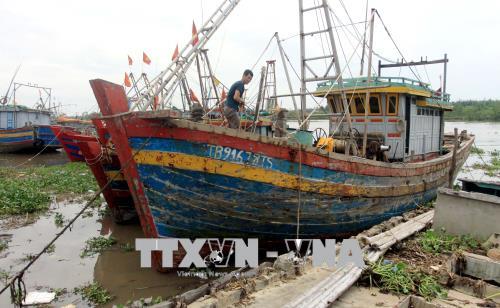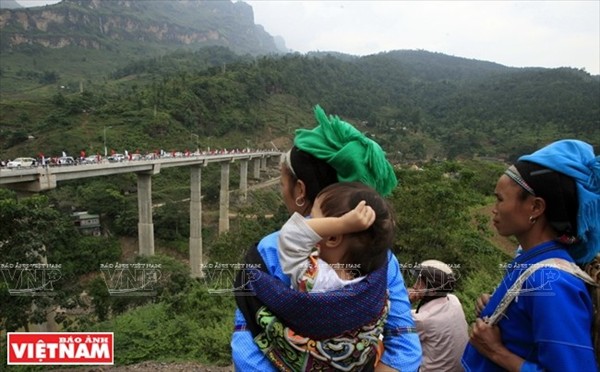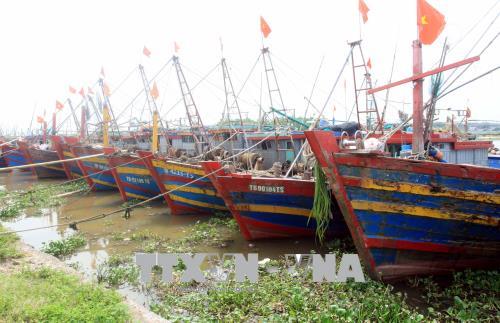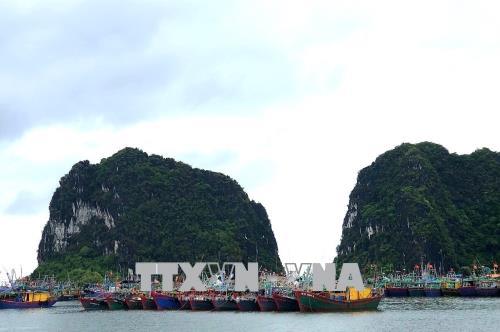 Storm Mulan heads toward northern coast
Storm Mulan heads toward northern coast
Home > Standpoints
Changes in the remote border area of Xin Man
By VNA 12/25/2017 11:00 |

The Coc Pai Bridge helps facilitate transportation in the area, improving the living standards of the locals.
Xin Man is a border district of Ha Giang Province which has great potential for development. However, the district is surrounded by high passes and deep streams that cause difficulties in transportation and trade activities with neibouring areas. Since the Coc Pai Bridge was built, the district has seen great changes.
Joy in the remote border area
The district of Xin Man in Ha Giang Province borders China to the North and has a total population of more than 58,000 people of 16 ethnic groups. The Nung ethnic group accounts for the majority with 43%, the Mong accounts for 23% and the remaining groups are the Dao, Tay, La Chi and Kinh.
In the past, to travel to the city of Ha Giang or neibouring districts, the locals in Xin Man had to cross an old small bridge over the Chay River. The bridge was often strongly shaken when motorcars crossed. Furthermore, when it was rainy or windy, it became very dangerous to travel on the bridge.
To ensure transportation safety for the locals and improve their living standards, the Ministry of Transportation decided to build the Coc Pai Bridge using 150 billion dong from JICA's loan and the Government’s counter capital.
The construction of the Coc Pai Bridge started on January 26, 2015, 60m from the old bridge. After about 20 months, the bridge was inaugurated and put into operation in early November 2016. The bridge not only helps connect routes between Xin Man and other neighbouring areas, but also gives many opportunities for economic, social and cultural development. With this bridge, local agricultural products can be easily transported to other places and tourism services have been increased.
Ly Van Hao, a villager in Chung Trai, 5km from the town of Coc Pai, said that previously the villagers had to cross the small and old bridge in the town to take agricultural products like corn and rice to the border market which is 45km from the hamlet. However, the bridge was often being repaired so the villagers had to walk to another bridge in a neibouring commune, several kilometers. Now, with this bridge, it takes them less time to get to the market.
For Nong Thi Va, a primary school teacher in Then Phang Commune, and her colleges, the new bridge helps wipe out their worries in the pass whenever they crossed the old bridge, especially in bad weather conditions or landslices. She said, “We felt very happy when the Coc Pai was built and we are no longer worried about going to class in harsh weather.
Coc Pai – the bridge helps change the mountain area of Xin Man
Located in the district of Xin Man, the Coc Pai Bridge was built under the transport sector’s credit project, stage 2, which used JICA’s loan and the counter capital of the Vietnamese Government. The bridge, 9m in width, has a total length of 832.77m, including 337.28m of the main bridge with 11 spans, and has two 60m high pillars, P5 and P6. The road leading to the bridge is 495.49m and has two pillars of P5 and P6 of 60m high.
Recalling the first days of construction of the bridge, Pham Ngoc Bien, Deputy Director of the Project 6 Management Board said that when watching the first trip carrying equipment to the construction site, we realised just how difficult it was because of the dangerous position. Therefore, all construction materials and equipment had to be transported from the direction of Lao Cai and gathered at the place which is 15km from the construction site. Furthermore, the harsh weather was also a factor that affected the progress of construction.
However, seeing the locals’ difficulties in travelling, all cadres and workers of the project overcame tremendous obstacles to complete the work. Bien said, “The bridge has now become a major work, beautifying the town. Furthermore, it is a clear evidence of effective investment in transportation from Japan’s ODA and the counter capital of the Vietnamese Government.
According Hoang Nhi Son, Chairman of Xin Man District People’s Committee, since the bridge was put into operation, it has helped connect Xin Man District in Ha Giang with Bac Ha District in Lao Cai and the Ha Noi-Lao Cai Highway. In the future, it will connect with Xin Man-Do Long Border Gate, contributing to the socio-economic development and ensure national defence in Xin Man as well as two provinces in western Ha Giang Province.
The authorities of Xin Man ordered the planting of many trees on the roads leading to the bridge to create a beautiful landscape for the bridge. When visiting the region, tourists will have a chance to enjoy quiet atmosphere amidst the magnificent natural landscape and participate in a series of tourism activities, such as fishing, picking wild vegetables, and enjoying local delicacies.
Talking about the new bridge, Fujita Yasuo, Chief Representative of JICA in Vietnam hoped that that the bridge will help further promote the friendship and mutual understanding between peoples in the two countries, especially in Xin Man, Ha Giang Province.
Photo
 Storm Mulan heads toward northern coast
Storm Mulan heads toward northern coast
 Storm Mulan heads toward northern coast
Storm Mulan heads toward northern coast
 Storm Mulan heads toward northern coast
Storm Mulan heads toward northern coast
 Storm Mulan heads toward northern coast
Storm Mulan heads toward northern coast